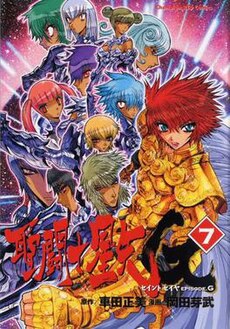Saint Seiya Episode.G
| Saint Seiya Episode.G | |

The inside cover of volume 7, displaying the protagonist, Leo Aiolia, along with most of the Titans
|
|
|
聖闘士星矢エピソード・ジー (Seinto Seiya Episōdo Jī) |
|
|---|---|
| Genre | Mythic fiction, Martial arts, Drama, Adventure |
| Manga | |
| Written by | Megumu Okada |
| Published by | Akita Shoten |
| Demographic | Shōnen |
| Imprint | Champion Red Comics |
| Magazine | Champion Red |
| Original run | December 19, 2002 – June 19, 2013 |
| Volumes | 20 |
| Manga | |
| Volume 0: Aiolos | |
| Written by | Megumu Okada |
| Published by | Akita Shoten |
| Demographic | Seinen |
| Imprint | Champion Red Comics |
| Magazine | Champion Red Ichigo |
| Original run | October 19, 2007 – January 19, 2008 |
| Volumes | 1 |
| Manga | |
| Saint Seiya Episode.G: Assassin | |
| Written by | Megumu Okada |
| Published by | Akita Shoten |
| Demographic | Seinen |
| Imprint | Champion Red Comics |
| Magazine | Champion Red Ichigo (former) Champion Cross (current) |
| Original run | April 5, 2014 – present |
| Volumes | 5 |
Saint Seiya Episode.G (Japanese: 聖闘士星矢EPISODE.G Hepburn: Seinto Seiya Episōdo Jī?) is a manga written and illustrated by Megumu Okada. A side-story and a derivative work of Masami Kurumada's Saint Seiya, it first started being serialized in the January 2003 issue of the monthly magazine Champion Red and was later compiled into volumes by Akita Shoten, with the first being published on June 19, 2003.
The story is set seven years before the events of the original Saint Seiya manga and six years after the death of the Sagittarius Gold Saint Aiolos, the brother of Episode.G's main character. It takes place in a fictional universe where the Greek gods cyclically reincarnate on Earth, often waging war on each other for dominance, and depicts the battle of the Gold Saints, warriors with superhuman powers who fight for Peace and Justice in the name of the Goddess Athena, to protect the Earth from the recently awakened Titan gods.
Although no English version of Saint Seiya Episode.G exists, it has been translated into various other languages by publishers from around the world, where it was well received, but not without controversy regarding its differences to Saint Seiya. In Brazil, it was published by Conrad Editora; by Panini Comics in Italy, Germany and France; Glénat in Spain; Editorial Ivrea in Argentina; Editorial Kamite in Mexico; and by Chuang Yi in Singapore.
...
Wikipedia
